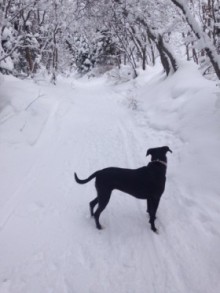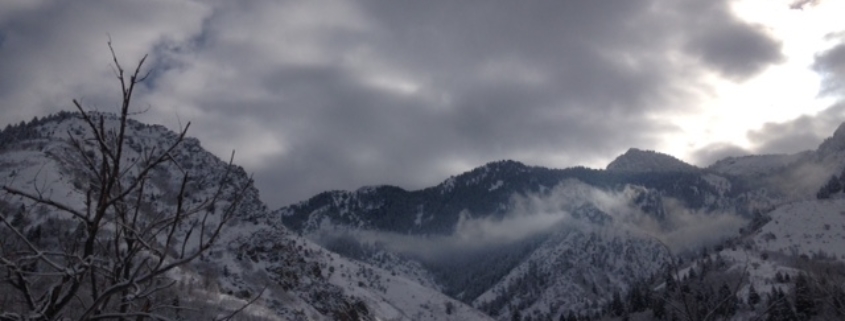Writing and Mindfulness

I pulled into my snow covered driveway after a long day of work. I locked my black Subaru, fidgeted with my keys ‘til I found the kiwi green colored one marking home, and unlocked the front door. I was greeted by my dog Amelie—shaking her whole black-lab-pit body in a tremor of excitement. I put down my bag, rubbed her belly, threw my leftover Tupperware containers in the dishwasher, peed, noticed how dark yellow the color of the liquid was (too much coffee), drank a glass of water from the kitchen, and grabbed the leash to take Amelie for a walk. I could feel a dull pang of hunger in my stomach and wanted to eat something, but I knew if I were to stop moving, sit down, I would not get back up, and so I did all this quickly, while the air was dry and cold, even inside, and the soft light was fading quickly into the devouring darkness of winter.
It was snowing when I stepped outside—a slushy, wet snow—and the cars splashed across the black asphalt through the wet Salt Lake City streets. As I walked, I listened to the podcast On Being. The program seeks answers to questions like, “What does it mean to be human? And how do we want to live?”
You know, the easy stuff.
This week, host Krista Tippett had Ellen Langer on the podcast. Langer is a social psychologist who in many ways began the “mindfulness” movement back in the seventies. For Langer, mindfulness is not connected to transcendental meditation or yoga (which she sees as sorts of means to an end) but merely the “simple act of noticing things.” As I walked, I couldn’t help but notice the parallels between writing and mindfulness. Because where else does writing start but in the noticing of things?
As Amelie trotted in front of me, I noticed the wet snow like clumps of slightly moistened flour, the variety of cars, from beat up Honda Civics to Black Escalades and small trucks. I noticed how the snow lit up the area in luminescence, reflecting the orange and white glow of fluorescent streetlights. I watched Amelie stick her black nose into the white snowdrifts, smelling something of which I was completely unaware, and as I held her leash I felt the tips of my bare fingers begin to numb. I looked inside the houses, or tried to, and I wondered about the people nestled behind the curtains in their houses along Oakley Street, each with their own story. You could write an entire anthology of stories, I imagined, a series of books, just listening to the people inside their houses on Oakley Street—or any street. Perhaps I would write a book like this one day. The sky began to fade from a whitish grey to a light black.
Langer continued by saying that most of us go through our lives in mindlessness, taking care of what is in front of us—work, kids, emails, social activities—and we then relax and kick back through entertainment and recreation in an equally mindless manner. But what we fail to do is notice and pay attention to what is front of us, which Langer argues has tremendous physical and mental benefits. We often equate rest and leisure with doing nothing and turning our brains off. But is this alone truly restful? Sometimes. I have spent entire weekends on the couch watching movies, thinking that was just what I needed. But I’d still feel exhausted when I showed up to work on Monday. Langer would say this phenomenon or experience has to do with mindfulness.
Langer conducted two famous studies in order to demonstrate this argument. In one, she found that hotel workers who thought of their rigorous daily duties as “exercise” rather than work began to reap the physical and mental benefits of exercise as if they were at the gym all day. They lost weight and reduced their blood pressure, all through simple awareness. In another study, she took two groups of older men and transported them both back twenty years, to a set designed to look as if it were the late fifties. The first group was told to pretend they were young men again for a week and the second to reminisce about the time period. Both groups showed cognitive and physical improvements, but the group that was told to pretend they were young improved dramatically more. Almost as if they had reversed time.
One of the most aware and mindful writers I’ve read over the last year is Norwegian Karl Ove Knausgård. I’m currently working on a paper about how exactly he is able to write some 3,600 pages about his very ordinary life over the course of six volumes and, for some reason, still have an audience willing to read it. Knausgård employs various literary strategies such as engaging voice, humor, and meticulous detail. But the main way he accomplishes his epic work? Awareness. He is aware of the minutiae of daily life. He doesn’t simply say, ”My brother and I spent the afternoon cleaning up the house.” He takes you into each room—the kitchen, the living room, the bathroom downstairs. He doesn’t just say, “My wife went into labor and we drove to the hospital.” He gives us a near minute-to-minute analysis of the entire ordeal. This is in no way original to Knausgård—Proust, Woolf, and Nabokov (a few of the most detail-oriented writers) were doing this long before. What makes Knausgård unique is the sort of juxtaposition of ordinary, everyday, blue-collar content alongside opulent detail. Knausgård, more than anything, is aware. And awareness is the key to writing. To be able to observe and describe the sights, sounds, tastes, smells, textures, facial expressions, and moods of a house, a character, or a conversation, is awareness, mindfulness. To be a writer is to be aware and to notice, and then translate into language. As Knausgård says about viewing everyday life:
Everyday life, which could bear down on us like a foot treading on a head, could also transport us with delight. Everything depended upon the seeing eye. If the eye saw the water that was everywhere in Tarkovsky’s films, for example—which changed the world into a kind of terrarium, where everything trickled and ran, floated and drifted, where all the characters could melt away from the picture and only coffee cups on a table were left, filling slowly with a falling rain, against a background of intense, almost menacing green vegetation—yes, then the eye would also be able to see the same wild, existential depths unfold in everyday life.

Mindfulness is often considered synonymous with “being in the present,” in the sense that if I am mindful, I do not worry about what has happened in the past or what will happen in the future (both of which are out of my control). Instead, I do my best to tune in with what is happening in the present. The same goes for writing. The writer must be mindful of the present if they are to create well-written dialogue, external descriptions, setting, and so on.
There is however, a downside to this awareness and mindfulness. For to be aware is to remove the blinders from our periphery. To observe and be mindful is to not only be aware of that which is front of us in the present moment, but to be aware of and mindful of what is going on all around us—police brutality, war, economic injustice, racial divides, gender issues, addiction, poverty, and so on.
After all, the world can be a cruel, lonely, dark place and I, personally, contend daily with this reality and do my best not to numb it through drugs, alcohol, sex, or Netflix, even though everything within me screams for this numbness. The difficult-to-obtain balance has always existed in the ability to hold the present moment of awareness without being sucked into the vortex of motherfucking existence.
It is not always the prettiest or easiest activity, to engage in awareness and mindfulness—it takes concentration, focus, and endurance—but it is one job of the writer. To notice and be able to convey what others see but perhaps do not fully understand or engage with. This is not to puff the writer up with a big ego, but to humble them for the responsibility that rests upon their shoulders.
I turned the corner of the block back to my house. I saw the orange fluorescent glow of streetlights turn into magical, snow globe prisms. I listened to the splashing of the cars, the muffled chomping of my boots on the sidewalk. Water now seeped into my wool socks and I felt my feet turn cool and damp. I smelled tacos in the air from the tiendita across the street. I walked up the sidewalk to my front door, undid the blue leash from Amelie’s collar, stomped my feet on the brown welcome mat, rubbed my dead hands together, fished the kiwi-green-colored-key out of my pocket, and opened the front door to my house, where everything was now imbued with a different hue of light.

Levi Rogers is a writer and coffee roaster out of Salt Lake City, UT. He lives with his wife Cat, his dog Amelie, and his many socks, all of which have holes. He’s currently an MFA candidate at Antioch University Los Angeles.





